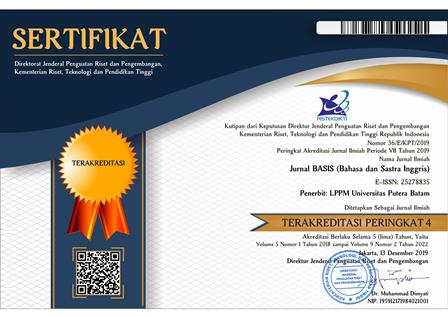ANALYSIS OF HOTS IN ENGLISH TEACHER-MADE TEST
DOI:
https://doi.org/10.33884/basisupb.v8i2.4479Keywords:
Bloom’s Revised Taxonomy, English Teacher-Made Test, English Simplified Syllabus, Higher Order Thinking SkillsAbstract
HOTS were three upper cognitive processes of Bloom's revised taxonomy by Anderson and Krathwohl (2001) which consisted of analyzing, evaluating, and creating. The objectives of this research were (1) to know the distribution of HOTS in English teacher-made test (2) to evaluate the relevancy of the English teacher-made test with the competencies in English simplified syllabus; (3) to know the reason for less appearance of HOTS in the English teacher-made test. This research focused on English teacher-made tests for grade X and grade XI in the academic year of 2020/2021 at the senior high school number 6 and senior high school number 11 in Bengkulu city. This study adopted a mixed-method as the research design. The first result displayed that HOTS obtained lower distribution rather than LOTS and MOTS in English teacher-made tests for grade X and grade XI at both schools. The second result showed that the English teacher-made tests for grade X and grade XI at both schools were relevant to the English simplified syllabus. The last, the reason for less appearance of HOTS in English teacher-made test at both schools came from two aspects. From the teachers' aspect, they needed more HOTS professional training to improve their understanding of HOTS. From the students' aspect, they needed to practice and learn more about HOTS questions, because most students could not work with HOTS questions.
References
Ahmad, K. (2018). The Implementation of Teaching LOTS and HOTS in English Teaching-Learning Process in Senior High School. RETAIN, 7(1), 121-128.
Anderson, L., & Krathwohl, D. (2001). A Taxonomy for Learning, Teaching, and Assessing. New York: Longman.
Arief, S. (2019). Higher Order Thinking Skills (HOTS) Analysis on Teacher’s Questions in the Final Examination of Bahasa dan Sastra Indonesia at Senior High School 7 Medan. Budapest International Research and Critics in Linguistics and Education (BirLE) Journal, 2(4), 172-178.
Arikunto, S. (2014). Prosedur penelitian: suatu pendekatan praktek. Jakarta: PT. Rineka Cipta.
Auliyana, M. (2019). Higher Order Thinking Skills Analysis of the English National Standardized School Examination (The Case of SMP Negeri 36 Semarang in the Academic Year of 2018/2019). Retrieved January 27, 2021, from https://lib.unnes.ac.id/34259/1/2201414153_Optimized.pdf
Bhakti, C. P., et. al. (2021). A design of online teacher training based on learning management system (LMS) to improve quality of teaching on higher order thinking skill (HOTS). BICED 2020.
Brookhart, S. M. (2010). How to Assess Higher-Order Thinking Skills in Your Classroom. ASCD. Retrieved January 26, 2021, from http://mpi.uinsgd.ac.id/wp-content/uploads/2018/07/Susan-M.-Brookhart-How-to-Assess-Higher-Order-Thinking-Skills-in-Your-Classroom-Association-for-Supervision-Curriculum-Development-2010.pdf
Brown, H. D. (2004). Language Assessment Principles and Classroom Practices. New York: Pearson Education, Inc.
Council, N. R. (2013). Education for Life and Work: Developing Transferable Knowledge and Skills in the 21st Century. Washington DC: National Academies Press.
Hairun, Y. & Tonra, W. S. (2020). Comparative Study On High Order Thinking Skills. International Journal Of Scientific & Technology Research, 9(3), 361-365.
Igbaria, A.K. (2013). A Content Analysis of the WH-Questions in the EFL Textbook of Horizons.
Kemendikbud. (2017). Modul Penyusunan Soal Higher Order Thinking Skill (HOTS). Jakarta: Direktorat Pembinaan SMA Ditjen Pendidikan Dasar dan Menengah.
Keshta, A., & Seif, A. (2013). Evaluating the Higher Order Thinking Skills in Reading Exercises of English for Palestine Grade Eight. Asian Journal of Education and e-Learning, 1(1), 9. Retrieved January 29, 2021, from https://www.ajouronline.com/index.php/AJEEL/article/view/52
Maili, S. & Sondari, E. (2020). English Teacher Perspective on Learning English at SMK Kartika VIII-1 South Jakarta. Journal BASIS, 7(1), 199-206.
http://ejournal.upbatam.ac.id/index.php/basis/article/view/1826
Ramadhanti, N. (2019). Pengaruh Pengalaman Mengajar Dan Banyaknya Pelatihan Yang Pernah Diikuti Terhadap Kinerja Guru Sd Se- Sekbin 1 Kecamatan Ketanggungan Kabupaten Brebes.
Slattery, J.M. & Carlson, J.F. (2005). Preparing an effective syllabus: Current best practices. College Teaching, 53, 159-165.
Sugiyono. 2013. Metode Penelitian Kuantitatif, Kualittative, dan R&D. Bandung: Alfabeta.
Sukmawijaya, A., Yunita, W., Sofyan, D. (2020). Analysing Higher Order Thinking Skills on the Compulsory English Textbook for Tenth Graders of Indonesian Senior High Schools. Joall: Journal of Applied Linguistics and Literature, 5(2),137-148. https://doi.org/10.33369/joall.v5i2.10565
Yunita, W., Syahrial, & Hati, G. M. (2020). English Teachers’ Knowledge on Higher Order Thinking Skills (HOTS). ENGLISH REVIEW: Journal of English Education, 9 (1), 2015-216.
Published
Issue
Section
License

















